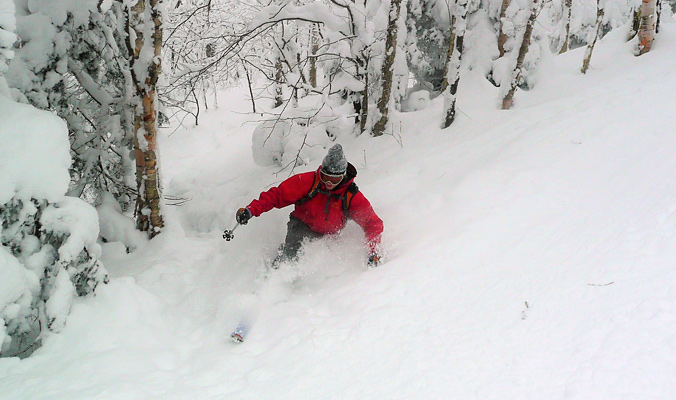
Goodman’s brother-in-law Bill Minter floats through powder on Mt. Mansfield’s Teardrop Trail, cut in 1937 by the Civilian Conservation Corps. [Photo] David Goodman
I was looking for vapor trails of the Golden Age of trailblazing. And then I found it: tromping around off the Long Trail, I spied a sliver of an old orange sign. Wiping away the snow, I made out the letters R D and A I: Tea-RD-rop Tr-AI-l. My partners and I looked up and spied a telltale opening in the trees. We burst through the discreet curtain of snow-laden fir branches and plundered the trove of powder that lay beyond. We felt like treasure hunters who had just found a fabled stash.
Vermont was the epicenter of CCC trailblazing. Credit for that goes to visionary state forester Perry Merrill, who received his forestry training in Sweden, where he saw skiing as a way of life. Maybe, he surmised, skiing could be a tourist attraction that would boost his poor, rural state of Vermont. Following the Depression, when he was informed that thousands of axe-wielding men from the CCC would be under his command, he had just the project for them: cut ski trails up the state’s tallest mountains. It was a crazy idea, but the lads got to work. Trails with names like Nose Dive, Teardrop, Chin Clip, Steeple and Bruce were all hacked out of the thick Vermont forest. A new era of skiing was born.
And then it ended abruptly. As chairlifts were erected on New England’s highest peaks, backcountry trails lost their appeal. Private entrepreneurs transformed skiing into a profitable resort-based commodity. Some of the CCC trails, like the Nose Dive at Stowe, became the nucleus of popular downhill areas. Others, like the Teardrop, faded nearly into oblivion. By around 1940, the last backcountry trails were cut in Vermont. Like dinosaurs, backcountry skiers, and their habitat, simply vanished from Vermont’s mountains.
But unlike dinosaurs they did not become extinct. They were just hibernating. By the early 1990s, those turned off by the industrial experience of resort skiing began searching for wild snow. They found it on the CCC trails, which they slowly brought back to life. Telemark skiers led the first charge. Snowboarders and alpine tourers eventually followed.
Some 75 years after Vermont’s first epoch of backcountry skiing, a new golden era of community-supported skiing has dawned. Groups of skiers and mountain bikers are blazing free, publicly accessible trails and glades from north to south, in local, state and national forests and on former downhill ski areas. This grassroots movement has spawned a bevy of groups like the Vermont Huts Association and Vermont Backcountry Alliance and various regional organizations. Nearby, New Hampshire’s Granite Backcountry Alliance and New York’s Adirondack Powder Skiers Association are leading their own community-supported movements.
Charlie Lord told me that the early trailblazers just wanted to build trails so that they could enjoy a full day skiing in the mountains. “We tried to make them interesting for ourselves,” he said. Little could he know that he was leading the way into the mountains for legions of skiers to follow. The old timers lit a torch; it dimmed, but never went out. That torch has now been passed to a new generation of Green Mountain explorers. That torch is lighting the way to look down the mountain, see the trees part to reveal a powdery passage and drop in to find buried treasure.
—
David Goodman is the author of Best Backcountry Skiing in the Northeast: 50 Classic Ski Tours in New England and New York (AMC Books). He is on the board of the Vermont Huts Association and is a founding member of the Vermont Backcountry Alliance. He lives in Waterbury Center, Vermont.











It’s interesting historically how the CCC trails were hacked to a specific lay of the land of the designer; the Bruce’s off-camber descent below the steep drop, say, or the big sweepers of the Thunderbolt. The modern version seems to be a kind of back country resort model- hillsides of glades instead of trails, and common skin track approaches instead of lifts. It’s all good, and representative of the time and ideas of the constructors.